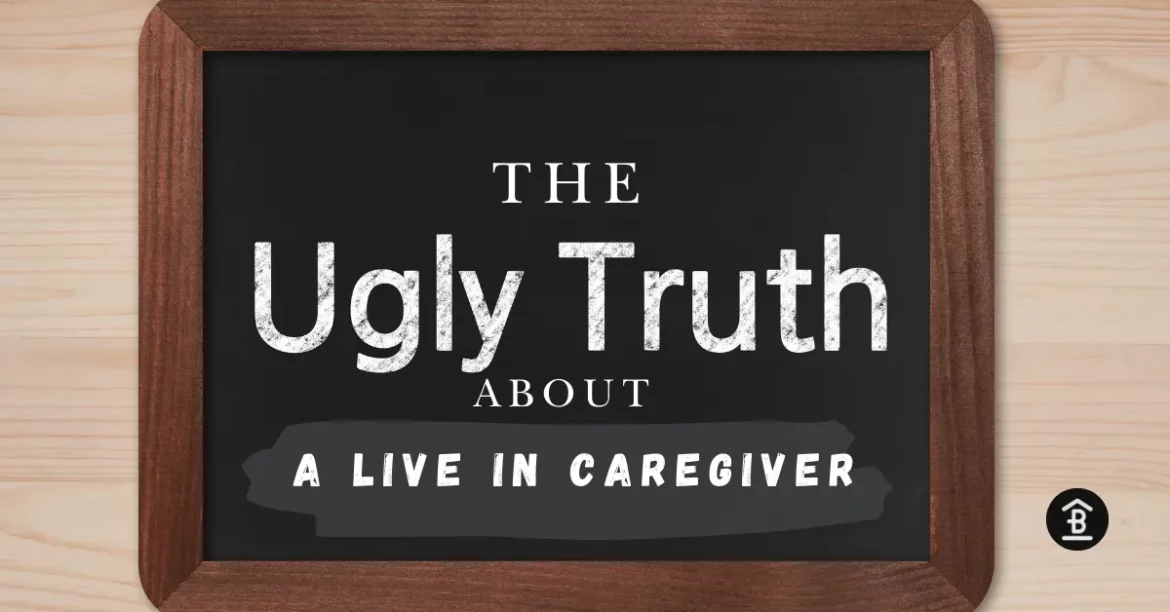The population of seniors has been rising with each year, and in 2022, about 17.3% of older adults aged 65 and above were a part of the American population. With this increasing population, the demand for caregivers has soared, making it a rather promising and fulfilling job to consider. However, are live-in caregiver jobs all about just doing good and making a difference? Does having a live in caregiver actually take away all your worries? Where there is light, there is darkness and just so, there is a flipside to the lives of caregivers and for those hiring them.
Before we get into the ugly truths about a live-in caregiver, let’s address …
What does live-in care and 24 hour care mean?
Both live-in or 24 hour care is a form of home care, that are temporary solutions that:
- Allow the senior to recover at home, from illness or surgery,
- Provide respite for family members to recover from burnout,
- Help the seniors age in place and assist them with activities of daily living, so that they don’t have to consider other senior living options.
The difference between live-in caregiver and 24-hour care
A live-in caregiver is a room and board live-in caregiver, like a professional flat mate, staying at home, day and night, to provide care based on the senior’s health guidelines. It is mandated that they are given around 8 hours break each 24 hours and accommodation to rest. The national average cost per month is around $20,000.
If you’re worried that your senior loved one needs care even at night, then 24 hour care is the better option. About 2 or more caregivers can rotate their working hours in shifts and ensure 24/7 support. However, this option is more expensive and multiple caregivers may overwhelm the senior. The national average cost per month is around $25,000.
5 ugly truths about live-in caregivers and how to deal with them
No 1: Having communication problems is unavoidable
While the assigned caregiver may be doing their best to ensure your loved one is in good hands, there will be times when they may not be able to share updates each day while you’re at work. Also based on the senior’s needs, the care plan may need to be changed from time to time and without informing the live-in caregiver, it may be difficult for them to adapt.
Solution: Be easy-going so that the caregiver can reach out to you. Remember you and the caregiver are a team. Have scheduled communication windows each day to understand how your loved one is doing, for discussing care plans and making you and the caregiver are both on the same page for any changes in plans.
No. 2: Live-In caregivers are not at your helm 24/7
There are strict laws in each state that ensure that caregivers aren’t exploited beyond their contractual agreement. Live-in caregivers normally work 8 to 10 hours per day and 56 hours per week. On occasions for overtime, you’ll have to compensate them for it. Before the set number of working hours in the contract has to be mentioned beforehand.
Solution: Allow them some time off their schedule so that they can look after their own families. In the long run, the caregiver will appreciate you caring for their work life balance and try to work better with you.
No. 3: Even the best live-in caregiver can get overwhelmed
If your elderly loved one has Alzheimer’s for example, or has extreme changes in behavior, it can get frustrating for the care provider to adapt to these challenges on a regular basis. It can also mean that the elderly patient needs more specialized care like memory care.
Solution: If you wish to continue with this caregiver, a productive discussion regarding a care plan or for the aide to take time off can be helpful. However, you may consider nursing home care if your senior patient needs better supervision and care.
No.4: Their plan for recreation for your senior may not match your vision
Some live in caregivers from experience or personal expectations might think sitting on the sofa all day in front of the TV with your elderly adult is a great activity as companionship. Whereas your vision might be for them can be to sit in the sun, bond over common topics and what not.
Solution: Before hiring, ask the would-be care provider about their hobbies and interests and see if it’s a good match for the senior. You can inquire about their usual routines for recreation for the patients and see if they meet your expectations.
No. 5: One moment of distraction for your live in care giver can be fatal
It’s implicit that a live in home caregiver has to be constantly vigilant around your elderly adult at home. However, there have been times when it’s either the care provider’s phone or the doorbell that caused your senior to slip and get into a nasty fall.
Solution: While it’s important for live-in caregivers to be connected to their phones for emergencies or attend to other home duties, it is important to be gentle and firm about establishing a minimal distraction policy during their hours of duty.
5 Misconceptions about in-home caregivers and truths
As the trend for live-in caregivers rises, so do growing misconceptions surrounding them. They not only stand in the way of care-seekers as it hampers their judgment. They also demotivate caregivers. So, we’re here to clear the air around these misconceptions! Now YOU can make the right decision for your loved one!
1. It’s always the caregiver’s fault not the patient’s
If you feel like the updates shared from the assigned caregiver do not match the senior’s perspective, you might want to look closely. While cases of abuse at the hands of caregivers do exist, you’ll be shocked to know, caregivers face abuse too!
Some forms of abuse can be getting beaten by the agitated patient, verbal abuse, overwork without compensation and so on. Please be vigilant and honor the live-in heroes! Have regular communication and be kind.
2. Independent Caregivers Are Hard to Find
Independent caregivers aren’t that hard to find. Reach out to your friends and relatives and ask them to refer someone to you. You can also get in touch with a local Area Agency on Aging (AAA) (churches, senior centers, or even your doctor’s- are great places to find one). Online ads and newspapers are a way to start with your search. There are many classified ads for such services.
Sometimes, even family members can step up as care providers. The advantage of independent caregivers is that they are usually not as expensive as their agency counterparts. However, a thorough background check is necessary when hiring one. The advantage of caregivers under agencies is that they are trained and vetted professionals.You can find Home Care services with us!
3. A Live-In Caregiver Salary Must be High
A live-in caregiver may charge anywhere between $10 to $30 per hour. You can get an estimate from this site.
A caregiver’s salary will depend on several factors such as the number of hours of duty, services, state rules and so on. Whether it’s an independent or informal caregiver, you may need to negotiate the rate.
4. My house and I Are Prepared for Home Care
You’ll have to take care of quite a few things before you can opt for live-in Home Care. First, compile your senior’s medical information and share it with the caregiver.
Select a separate room for your caregiver as they need their personal space. Also, ask your caregiver if they have any requirements so that their stay is comfortable too.
5. Live-In caregivers Only Look after Routine Tasks
As mentioned, the basic requirements for caregivers is to assist with daily activities like bathing, eating, and reading etc. They may also help with managing finances, providing transportation, and maintaining medication. Many caregivers are certified to help with medical assistance. Some caregivers may offer a one-stop solution.
That being said, don’t hesitate to hire a caregiver for the sole purpose of maintaining the daily routine of your loved one. We all know how demanding time schedules can be, especially if you have a family to look after. Seniors will always appreciate the assurance of having good company and care.
Final thoughts
Live-in caregivers can be an invaluable asset, gifting you and your family peace and invaluable support. There are challenges for caregivers in this industry along with misconceptions.
We’re hoping this article gave you insight and truth to many of these prejudices. It is important to communicate with your family care providers, treat them with compassion and empathy, and a positive, and safe caring environment can be created for all.
Here are some related articles that you might want to check out:
- Legal Issues for Caregivers: Common Ones They May Face
- How to Become a Caregiver: Step-by-Step Guide
- Qualities of Great Caregivers: 12 Most Essential Ones
If you like what we shared with you, share these common misconceptions and the counter-facts with your loved ones, and help them in your own little way. In case of any queries/questions, leave us a comment down below, and we’ll get back to you at the earliest!
FAQs
What does a caregiver do that works the overnight shift?
The caregiver is responsible for aiding in any bathroom trips, medication management and monitoring of vitals of the senior. While the elderly adult sleeps, the caregiver stays vigilant and ensures overall safety for the senior.
Are there any pros and cons to hiring a live in caregiver?
Here are the pros:
- The caregiver is available 24/7 which can be a source of comfort and support.
- As there is one caregiver responsible, the senior can form a good bond, which can facilitate better care.
- They are more affordable for hiring.
Here are the cons:
- The live-in caregiver will need 8 hours of rest each day and if your senior needs support during the night, you may have to consider another caregiver for the night shift.
- The elderly adult may find it monotonous seeing the same caregiver daily and vice versa.
- Depending on one live-in caregiver will lead to his/her burning out or becoming overwhelmed.
Who qualifies as a caregiver under Medicare rules?
There are no specific qualifications to be a caregiver under Medicare rules, but the person providing care must be someone who is either related to the beneficiary or has been appointed by the beneficiary.
Do you have to pay taxes on caregiver wages?
The answer to this question is complicated. In general, caregivers are not considered employees, and as such, their wages are not subject to payroll taxes. However, if a caregiver is classified as an employee, they have to pay income taxes.


2 comments
Thank you for every other great article. The place else may anybody get that type of info in such a perfect approach of writing? I’ve a presentation subsequent week, and I am on the look for such information.
No matter if some one searches for his essential thing, thus he/she desires to be available that in detail, so that thing is maintained over here.
Comments are closed.